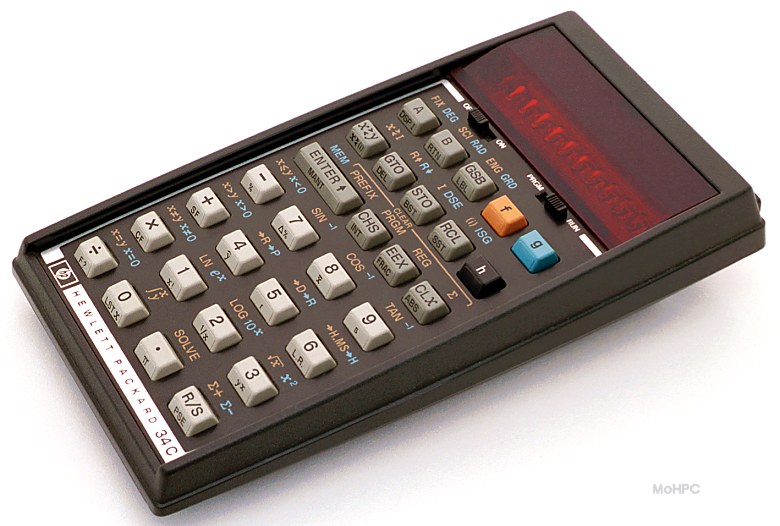The HP-34C was the high-end scientific programmable member of the 30 series. In addition to a full complement of scientific and math functions, it was the first to offer root finding and numerical integration.

New to the HP-34C, the Solve function could find real roots for any equation which could be expressed in the form f(x) = 0. (Any single variable equation.) To use it, the user keyed in a subroutine to evaluate f(x) which left the value in the X register. The user then entered two initial guesses to give the calculator a starting range and then pressed Solve and the label of the subroutine.
The calculator would then evaluate f(x) until it found the first root. Additional roots could be found by entering different initial guesses. The calculator would display an error if there were no roots.
Before calling the subroutine, Solve would fill the entire stack with the value of X. Because pops copied the top of the stack down, this allowed X, to be retrieved from the stack as many times as the subroutine required.
The manual contained a great deal of information on interpreting results, checking accuracy, efficient coding of the formula, as well as background information on how Solve worked.
Numerical integration was also new to the HP-34C. As with the Solve function, the user keyed in a subroutine to evaluate f(x) which left the value in the X register. The user entered the lower and then upper limit of integration and then pressed the integrate key followed by the subroutine label.
You may recall that some of the programs and subroutines you executed earlier in this handbook required several seconds to yield an answer. This may not seem too long, but when the calculator must execute the subroutines many times—as it does when you press [integrate]—you can' expect an answer right away. Most integrals will require on the order of 30 seconds to 2 minutes; but some integrals will require even more. Later on we'll discuss how you can decrease the time somewhat; but for now press [integrate] 0 and take a break (or read ahead) while your HP-34C takes care of the drudgery for you.
In fact, the user could adjust the time spent integrating by telling the calculator how many digits were significant. This controlled the integration step size and was done by simply setting the display format to show no more digits than required in the final answer.
The Manual devoted a 32-page appendix to a more detailed description of the integration function and a 21 page appendix on advanced uses of Solve.
The factorial function (x!) had appeared on many previous HP handhelds, but on the HP-34C, for the first time, the factorial key really calculated Γ(x+1) (Gamma). For positive integers, this was the same as a factorial, but the Gamma of any number could also be calculated by subtracting 1 and pressing x!. The HP-34C also included a full complement of scientific and mathematical functions.
The HP-34C had 70 lines of permanent program space. As programs grew larger than 70 lines, registers were converted into additional program space starting at R.9 and ending at R0. There were 20 registers (not including the I register) and each register converted into 7 lines of program space. Thus with all registers (except I) converted to program space, there were 210 program lines.
The HP-34C used label programming with the labels 0-9 and A and B. There were dedicated A and B keys allowing these two subroutines to be called with a single keystroke. (Other subroutines required GSB followed by a number.) Subroutines could be nested 6 deep.
The HP-34C provided indirection via a dedicated I register like the HP-67 & HP-97. The I register itself was controlled by STOring or RCLing I and indirection was achieved by STOring or RCLing (i). Indirection was allowed on STO, RCL, GTO, GSB, the display modes and exchange (exchange X with the register indicated by i.)
A negative number could be stored in I, in which case GTO I and GSB I meant to branch backwards to the line specified by the absolute value of the number in I. This saved time and labels. (The HP-29C & HP-19C had a similar feature but jumped back I lines.)
![]() Front view (~59K)
Front view (~59K)
![]() Three quarter view (~85K)
Three quarter view (~85K)
![]() View from the top end (~58K)
View from the top end (~58K)
![]() 30 series rear view (~31K)
30 series rear view (~31K)
Price: $150
Introduction-Discontinuation: 1979-1983
![]() Go back to the main exhibit hall
Go back to the main exhibit hall
![]() Next Calculator Made
Next Calculator Made
![]() Previous Calculator Made
Previous Calculator Made